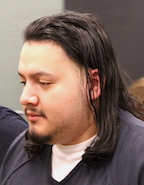Connie Koontz and Sophia Renkin were murdered in their homes in January 2019. On Thursday their killer received two life sentences without the possibility of parole in addition 55 years, ensuring he will never be free again.
The murders of Gardnerville Ranchos residents Connie Koontz and Sophia Renkin affected not just their families, but an entire community, their relatives testified on Thursday.
When Koontz’ daughter Madison was told by her cousin that her mother had been killed, she said she screamed and fell down.
“The date will haunt me when my worst nightmare came true,” she testified on Thursday. “It breaks my heart that I can’t call my mom. I can’t put into words. Her light was ripped from this world for absolutely no reason. She had so much love to give.”
Renkin’s nephew Brett Hooyerink testified about cleaning his aunt’s home so his father, who suffered a nervous breakdown after learning of her death, wouldn’t see the mess the murderer left.
Hooyerink pointed out that when serial killer Wilber Martinez-Guzman had the opportunity to express remorse, he remained silent.
“I want to know what made the defendant feel entitled to take the things that my aunt worked so hard for — that Connie Koontz and the Davids worked so hard for,” he said.
District Judge Tom Gregory said he agreed with the assertion that Martinez-Guzman was a serial killer, who should never be free again.
While acknowledging that Martinez-Guzman was 19 in January 2019 when he terrorized Western Nevada, Gregory said that the aggravators far outweighed anything else.
“When you killed Connie, that alone put the community on edge,” Gregory said. “Then 3-4 days later when you killed Sophia, the community was shook. People had guns walking through the neighborhoods. There were a lot of people who didn’t have guns who wanted to buy one.”
That Martinez-Guzman would receive the maximum sentence was an almost foregone conclusion.
“There is a question if you had remained out of custody whether you would have kept killing people,” he said. “You are a person who should be segregated from the community for the rest of your life.”
Martinez-Guzman received two life sentences without possibility of parole, with deadly weapon enhancements of 96-240 months and two sentences of 72-180 months for burglary while in possession of a deadly weapon.
All of the sentences are to be run consecutively with each other and with the sentence Washoe County District Judge Connie Steinheimer pronounced on Monday.
On Thursday morning, Douglas County District Attorney Mark Jackson presented the case for giving Martinez-Guzman the maximum.
Jackson disputed Martinez-Guzman’s claim that he killed Koontz and Renkin, and then Jerry and Sherry David for money for drugs and to keep making payments on the BMW that he used to travel to the crimes.
I wanted money for the drugs and for the car,” he told Washoe County Detective Stefanie Brady during a Jan. 19, 2019 interview. “I didn’t want to lose my car. I didn’t have work.”
He pointed out that the total cash Martinez-Guzman obtained by selling items from his thefts was $179, or $44.75 cents per murder, far less than the car payment that was due.
Martinez-Guzman laid in wait for both Koontz and Renkin when they came to investigate the break-in.
“He sought a tactical advantage,” Jackson said.
While Martinez-Guzman looted Koontz’ home, he didn’t take anything from the Renkin home after he chased her down and shot her.
But it was one of the items that he took from Koontz that led to his capture some 10 days after her murder on Jan. 9, 2019.
Koontz had purchased an Apple iWatch, and because she kept the boxes, investigators found the box.
Martinez-Guzman had thrown Koontz’ new iPhone 10 out a window as he was driving back to Carson City after he realized it was on and tracking him.
Jackson credited Investigator Steve Schultz with discovering that someone had turned on the watch and tried to use an email address to access it. That email address belonged to Martinez-Guzman’s mother and then it was a matter of finding him.
When he was arrested Jan. 19, 2019, he still had several of Koontz’ items in his car, including a Walmart nametag from where she worked.About 40 people watched the proceedings on Thursday. Jackson avoided showing the most graphic photos by having them sealed so the judge could look, but they wouldn’t appear publicly.
 Wilber-Martinez Guzman
Wilber-Martinez Guzman